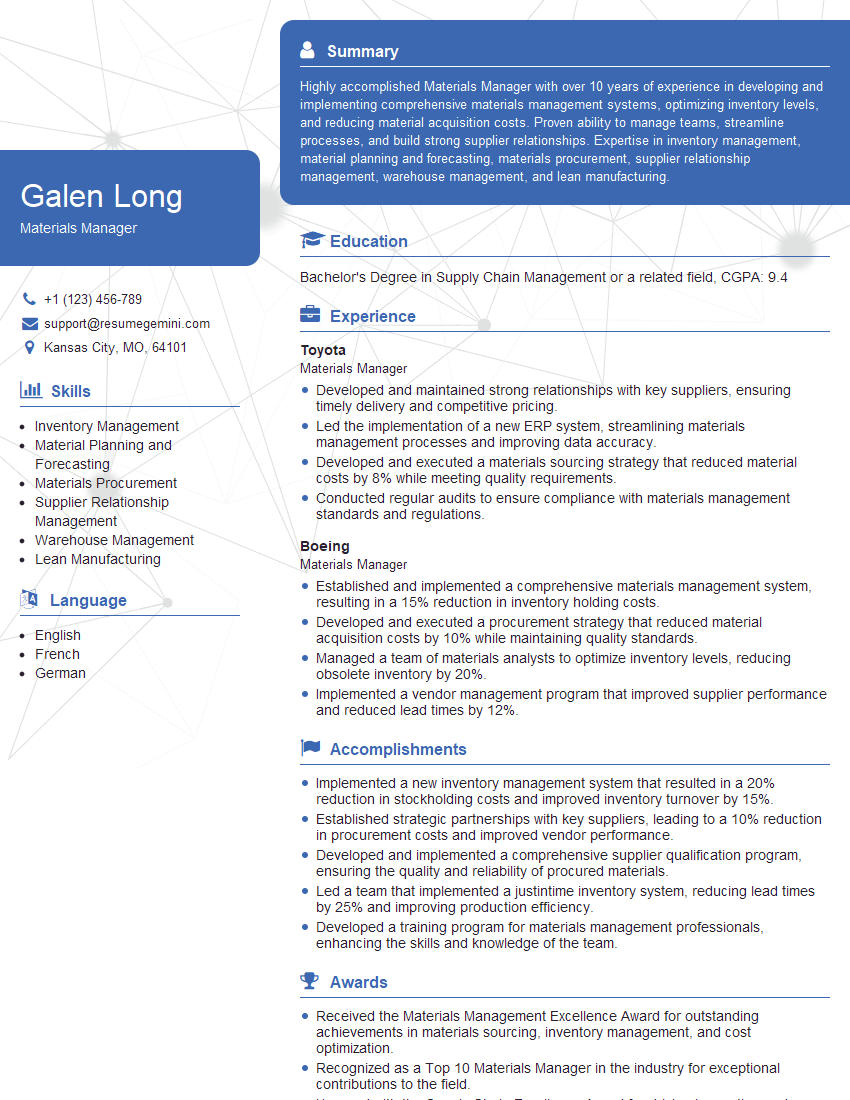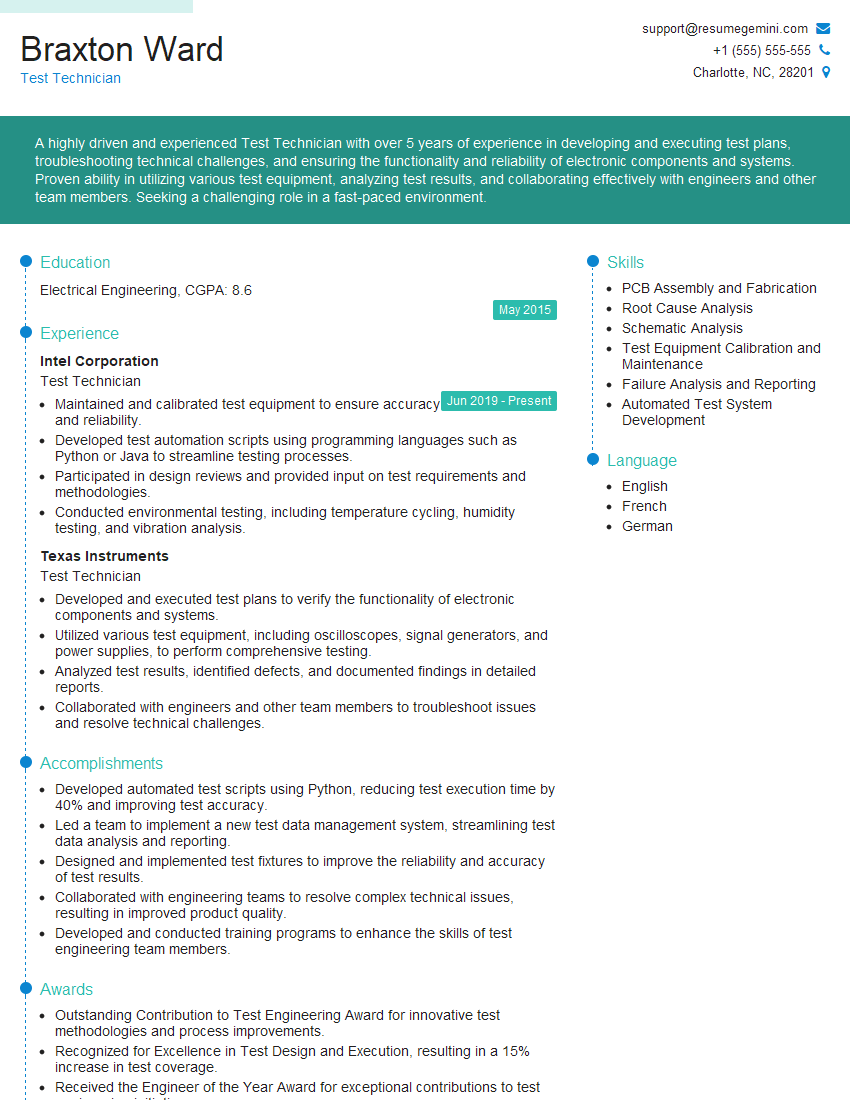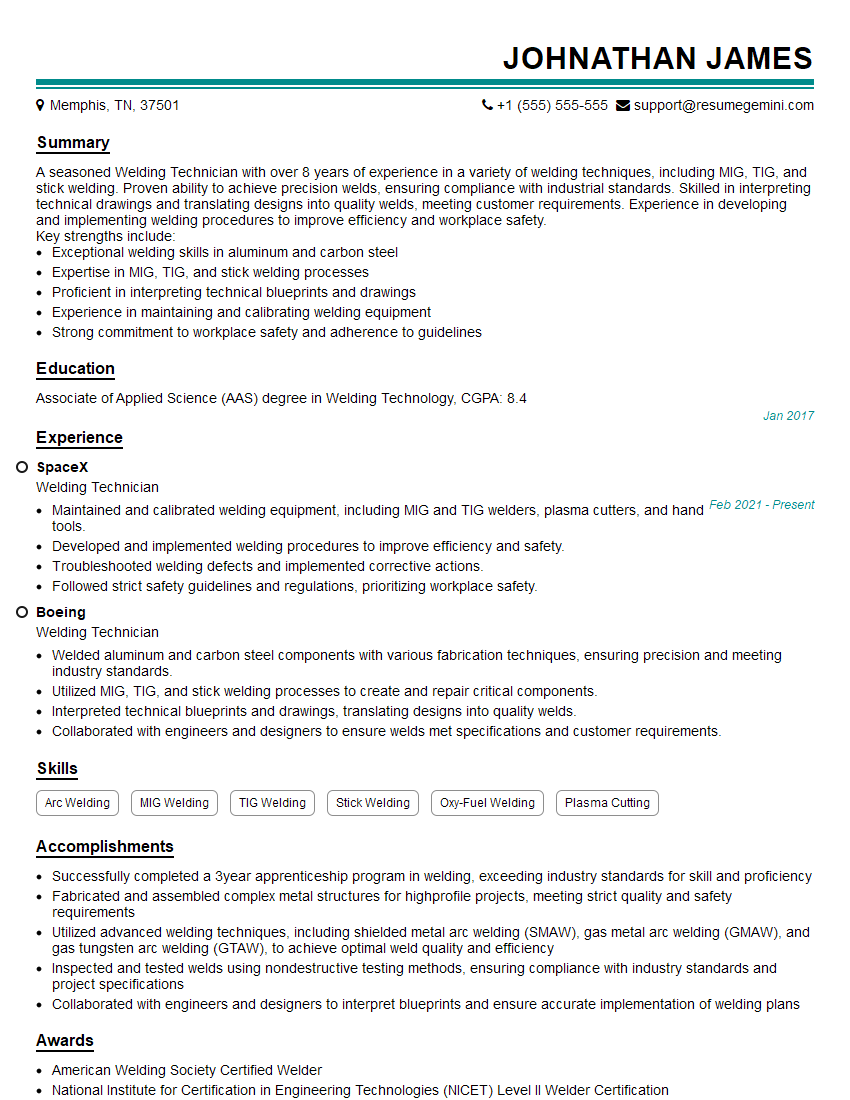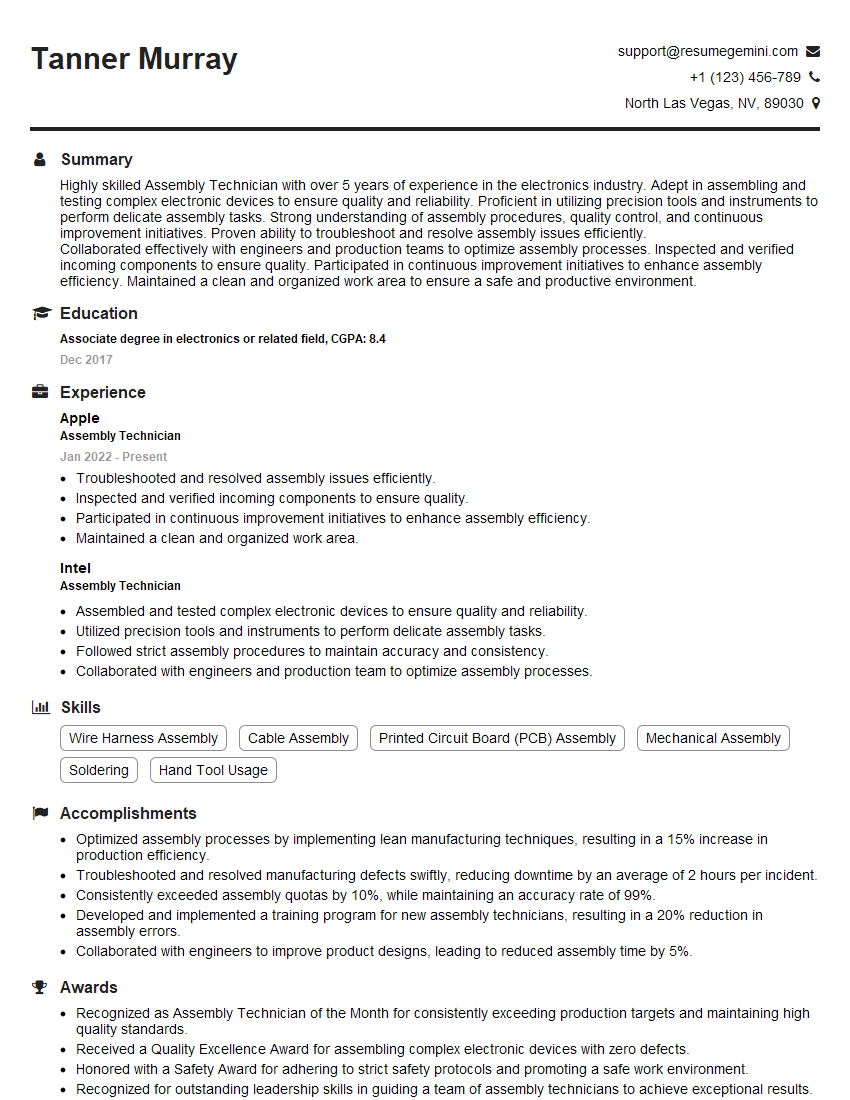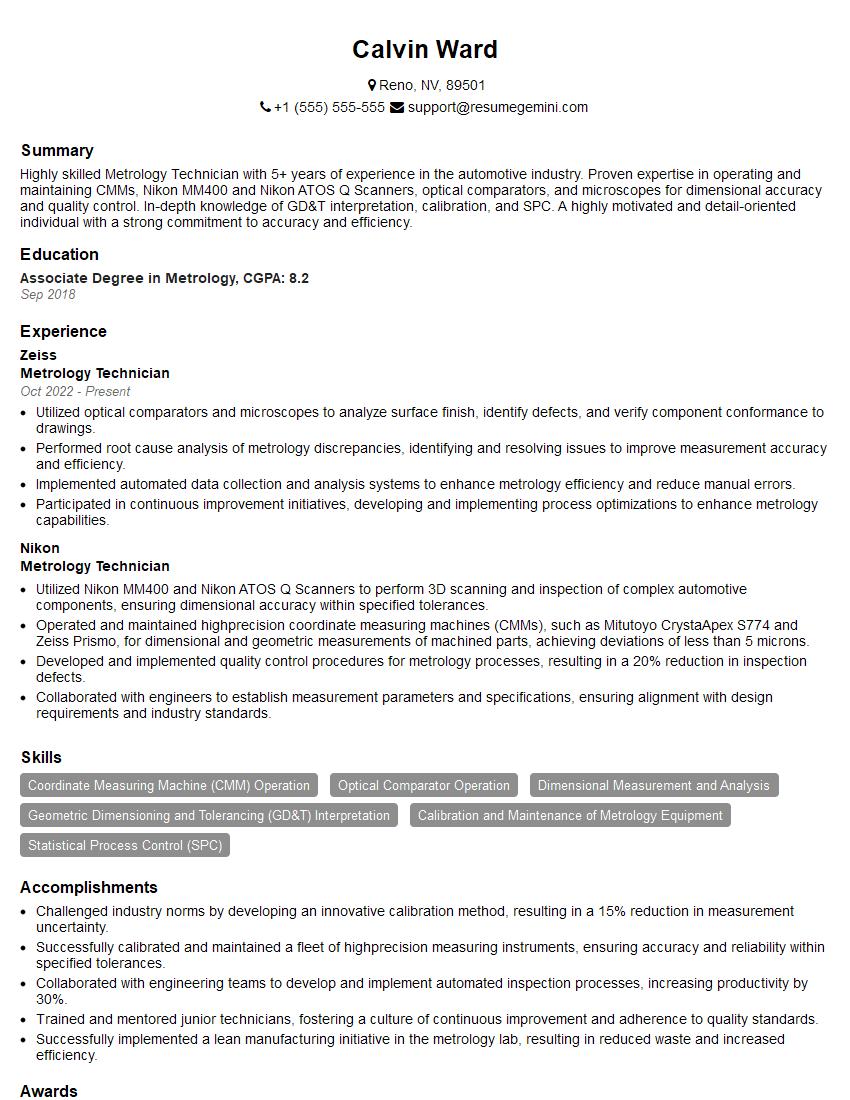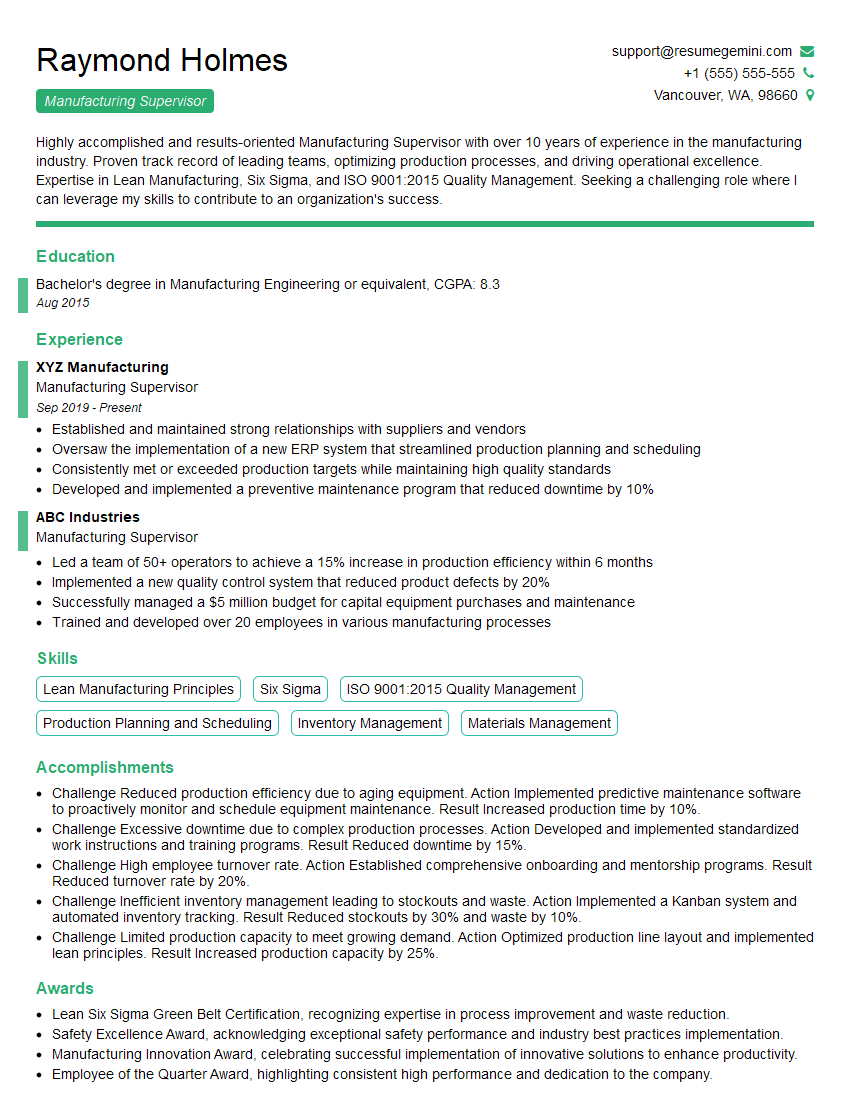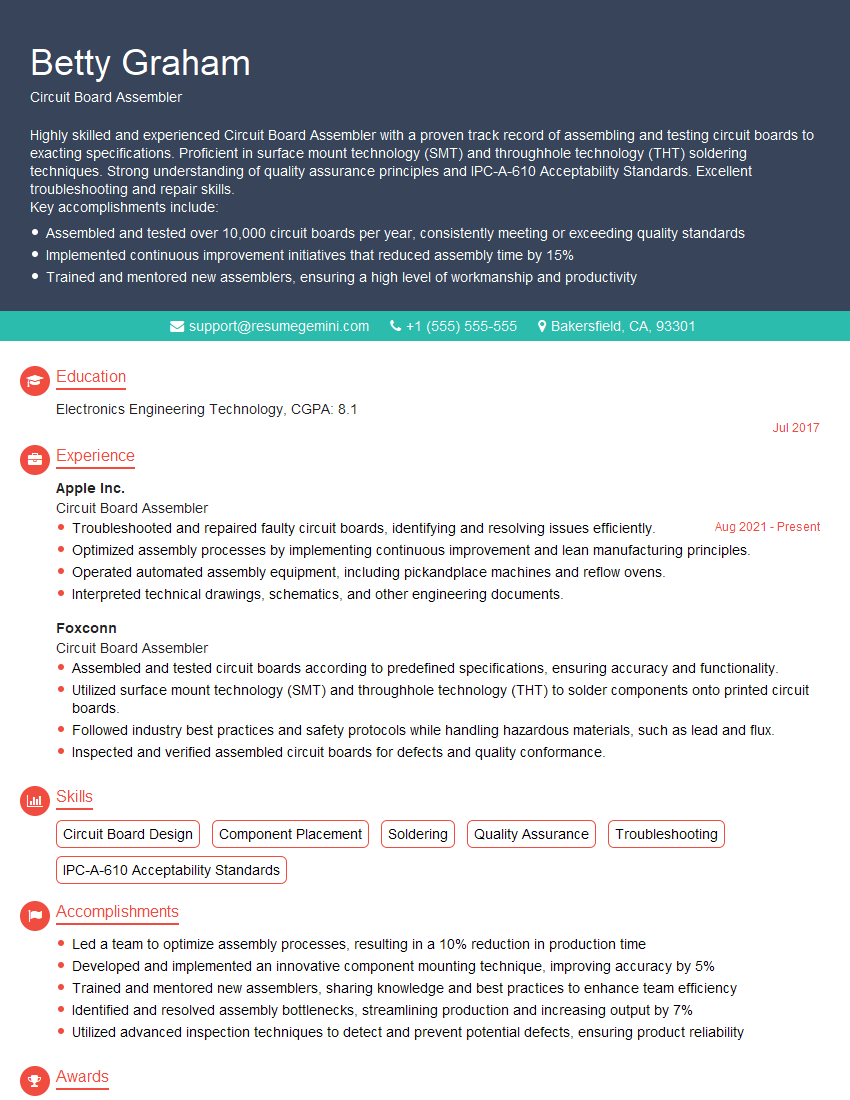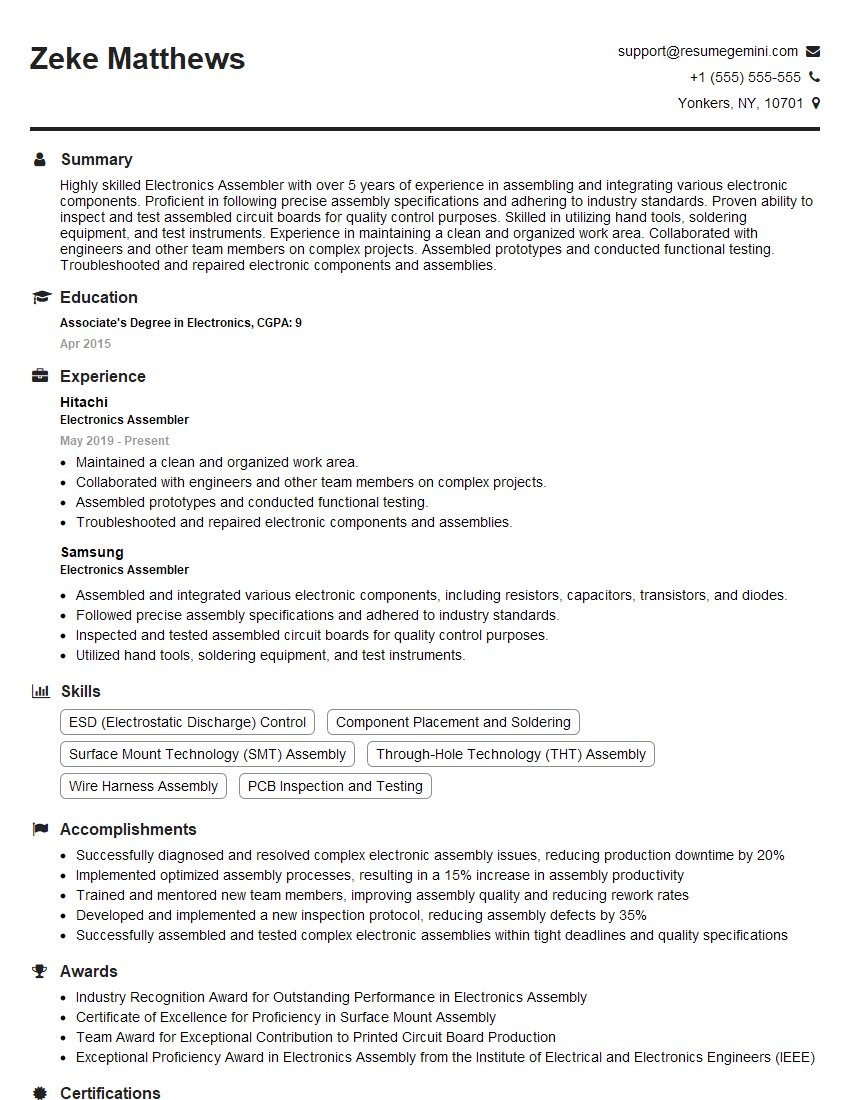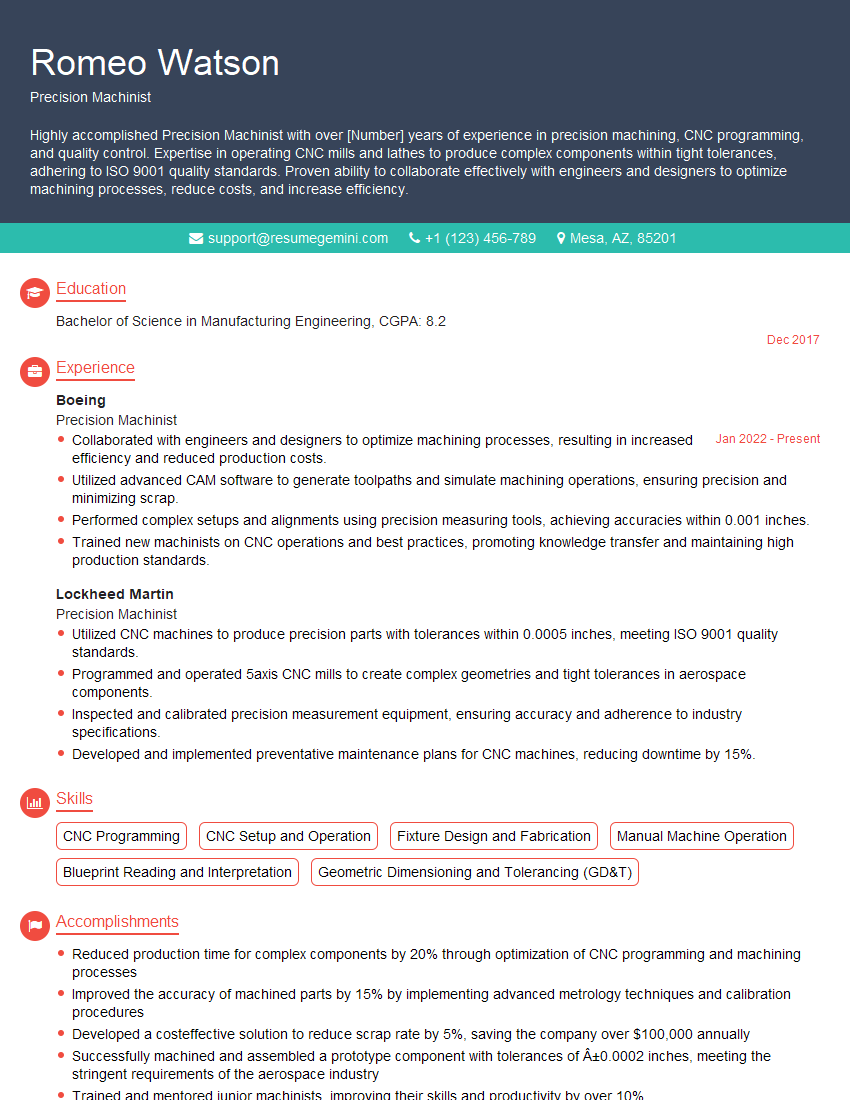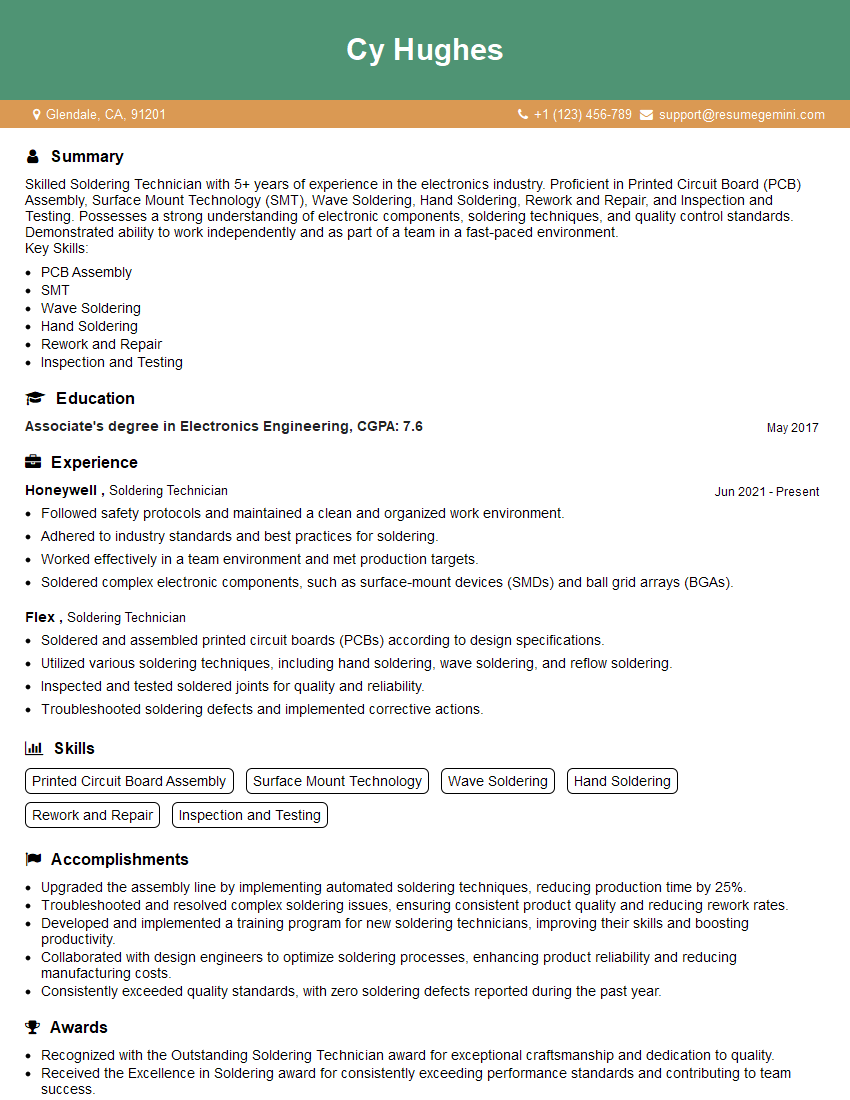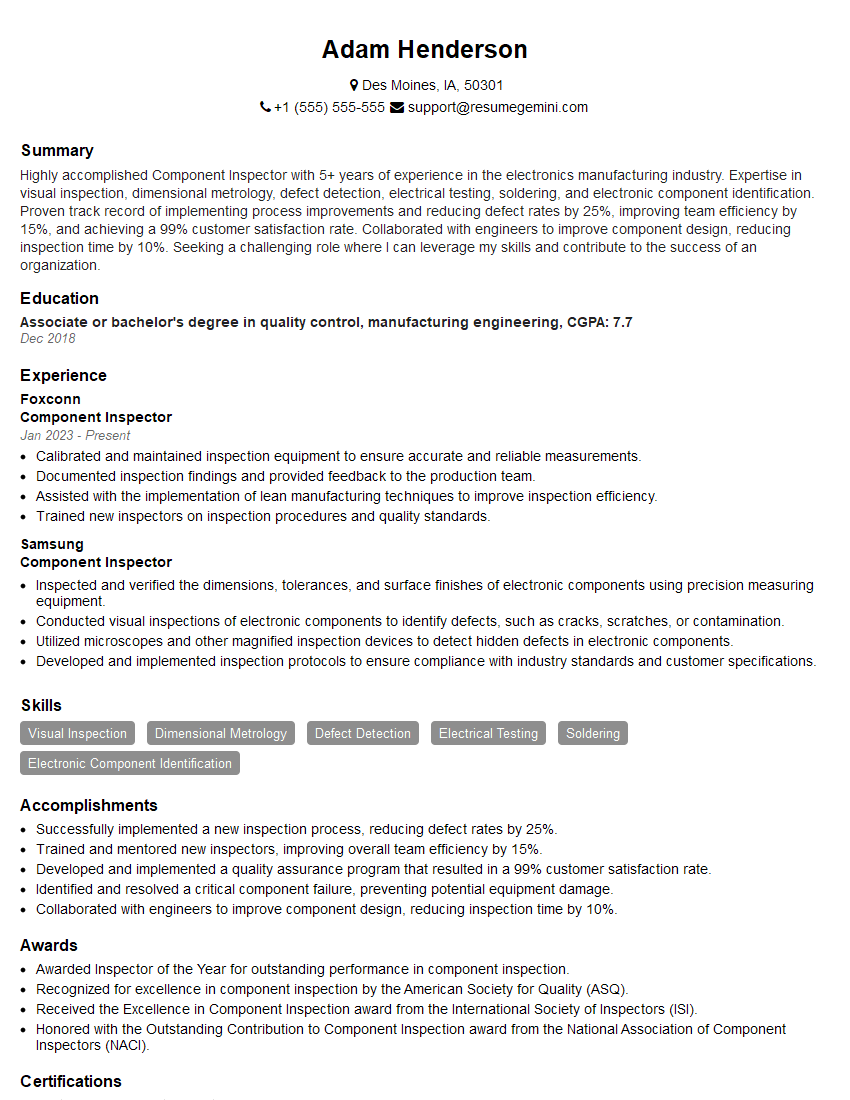The thought of an interview can be nerve-wracking, but the right preparation can make all the difference. Explore this comprehensive guide to Component Fabrication interview questions and gain the confidence you need to showcase your abilities and secure the role.
Questions Asked in Component Fabrication Interview
Q 1. Describe your experience with different component fabrication techniques.
My experience in component fabrication spans a wide range of techniques, from traditional methods to advanced automated processes. I’m proficient in several key areas:
- Printed Circuit Board (PCB) Assembly: This includes both through-hole and surface mount technology (SMT) assembly, utilizing various soldering techniques and automated pick-and-place machines. I’ve worked extensively with reflow ovens and wave soldering machines, optimizing processes for different component types and board densities.
- Wire Bonding: I have experience in both thermocompression and ultrasonic wire bonding, crucial for integrating microchips and other delicate components into larger assemblies. This requires precise control and a keen eye for detail to avoid shorts or broken connections.
- 3D Printing of Components: I’ve explored additive manufacturing techniques to prototype and even create small-scale production runs of custom components. This offers significant advantages in rapid prototyping and customized designs.
- Machining: I’m familiar with various machining processes, including milling and turning, to create precision components from metals and plastics. This is particularly useful for creating fixtures and housings for electronic assemblies.
In each of these areas, I’ve focused on optimizing efficiency and minimizing defects, constantly seeking ways to improve the fabrication process. For instance, in SMT assembly, I’ve experimented with different solder paste formulations and reflow profiles to achieve optimal joint strength and reliability.
Q 2. Explain the importance of quality control in component fabrication.
Quality control is paramount in component fabrication; it’s the backbone of reliable and functional products. A single faulty component can lead to catastrophic system failures, particularly in critical applications like aerospace or medical devices. My approach to quality control is multifaceted:
- Incoming Inspection: Thoroughly inspecting all incoming materials and components to ensure they meet specifications. This includes verifying dimensions, tolerances, and material properties.
- Process Monitoring: Implementing real-time monitoring of fabrication parameters such as temperature, pressure, and flow rates to detect deviations from the optimal process window.
- Statistical Process Control (SPC): Utilizing SPC techniques to analyze process data and identify trends that may indicate potential problems before they lead to defects.
- Automated Optical Inspection (AOI): Employing AOI systems to automatically detect defects such as missing components, solder bridges, and short circuits. This is especially valuable in high-volume production.
- Functional Testing: Rigorous testing of finished components to ensure they meet functional specifications. This could involve electrical testing, mechanical stress tests, or environmental testing depending on the application.
Think of it like baking a cake: you need to carefully measure ingredients (incoming inspection), follow the recipe precisely (process monitoring), and perform taste tests to ensure quality (functional testing). Skipping any of these steps risks a poorly made cake, or in our case, a faulty component.
Q 3. What are the common challenges in component fabrication, and how do you address them?
Component fabrication presents several challenges. Common issues include:
- Component Availability: Supply chain disruptions can impact the availability of crucial components, leading to delays and increased costs.
- Process Variability: Even with well-controlled processes, some variability is inevitable. This can lead to inconsistent quality and requires careful monitoring and adjustment.
- Defect Rates: Minimizing defects is a constant challenge. Defects can be caused by many factors, from improper handling to equipment malfunction.
- Cost Optimization: Finding the optimal balance between quality, speed, and cost is crucial for profitability.
My approach to addressing these challenges involves:
- Diversifying Suppliers: Mitigating risks associated with component availability by working with multiple reliable suppliers.
- Process Optimization: Continuously improving processes through data analysis, automation, and operator training.
- Root Cause Analysis (RCA): When defects occur, conducting a thorough RCA to identify the underlying cause and implement corrective actions to prevent recurrence (e.g., using the 5 Whys technique).
- Lean Manufacturing Principles: Applying lean manufacturing principles to eliminate waste and improve efficiency, ultimately reducing costs.
Q 4. How do you ensure the accuracy and precision of fabricated components?
Ensuring accuracy and precision is achieved through a combination of meticulous processes and advanced technologies:
- Precise Measurement Equipment: Utilizing high-precision measurement tools like CMMs (Coordinate Measuring Machines), microscopes, and calipers to verify component dimensions and tolerances.
- Automated Assembly Equipment: Employing automated pick-and-place machines and other automated equipment to minimize human error and achieve consistent placement accuracy.
- Process Control Systems: Implementing robust process control systems to maintain consistent parameters such as temperature, pressure, and flow rates throughout the fabrication process.
- Jig and Fixture Design: Designing and using custom jigs and fixtures to hold components in place during assembly, preventing misalignment and ensuring consistent results.
- Calibration and Maintenance: Regular calibration and maintenance of all equipment to maintain accuracy and prevent malfunctions.
For example, in PCB assembly, using a properly calibrated pick-and-place machine with vision systems ensures accurate component placement, while a reflow oven with precise temperature control guarantees optimal solder joints. This precision is critical for reliable circuit functionality.
Q 5. What are your preferred methods for troubleshooting component fabrication issues?
My troubleshooting approach is systematic and data-driven:
- Identify the Problem: Clearly define the nature and extent of the problem. This includes gathering data on the frequency, location, and type of defect.
- Gather Data: Collect data on process parameters, material properties, and operator actions to identify potential contributing factors. This might involve reviewing process logs, inspecting defective components, and interviewing operators.
- Analyze Data: Use statistical methods and data visualization techniques to identify patterns and potential root causes. This might involve control charts, histograms, or Pareto diagrams.
- Develop Hypotheses: Formulate hypotheses about the root causes based on the data analysis.
- Test Hypotheses: Conduct experiments or trials to test the hypotheses and determine the most likely root cause.
- Implement Corrective Actions: Implement corrective actions to address the root cause and prevent recurrence. This might involve adjusting process parameters, modifying equipment, or improving operator training.
- Verify Effectiveness: Monitor the process to verify the effectiveness of the corrective actions and ensure that the problem has been resolved.
I often use tools like fault trees and fishbone diagrams to visually represent the potential causes and effects, helping me systematically eliminate possibilities until I identify the root cause.
Q 6. Describe your experience with different types of soldering techniques.
My experience encompasses a variety of soldering techniques, each chosen based on the specific application and component type:
- Through-Hole Soldering: I’m skilled in both manual and automated through-hole soldering, using techniques like hand soldering with an iron and wave soldering for mass production. This requires precision to avoid cold solder joints and shorts.
- Surface Mount Technology (SMT) Soldering: I’m proficient in both reflow soldering and hand soldering for SMT components. Reflow soldering, using a reflow oven, is essential for high-volume production and fine-pitch components. Hand soldering is valuable for smaller-scale projects or repairs.
- Specialized Soldering Techniques: I have experience with specialized techniques like laser soldering for delicate components and ultrasonic soldering for high-frequency applications. These techniques require specialized equipment and training.
The choice of soldering technique is critical for achieving reliable and durable connections. Factors to consider include component size, pitch, material, and heat sensitivity. For instance, fine-pitch SMT components require the precision of reflow soldering, while larger through-hole components can often be effectively soldered manually.
Q 7. What safety measures do you employ during component fabrication?
Safety is paramount in component fabrication. My approach encompasses several key aspects:
- Personal Protective Equipment (PPE): Consistently using appropriate PPE, including safety glasses, gloves, and anti-static wrist straps to prevent injuries and ESD (Electrostatic Discharge) damage to components. This is non-negotiable in every aspect of my work.
- Proper Handling of Chemicals: Following strict safety procedures when handling solvents, fluxes, and other chemicals, including proper ventilation and disposal methods. Material Safety Data Sheets (MSDS) are always consulted.
- Equipment Safety: Operating all equipment according to manufacturer instructions and regularly inspecting equipment for damage or wear. This includes ensuring proper grounding and lockout/tagout procedures.
- Ergonomics: Maintaining proper posture and utilizing ergonomic tools to minimize strain and prevent repetitive motion injuries. This is especially important during prolonged manual tasks.
- Emergency Procedures: Being familiar with and practicing emergency procedures, including fire safety and first aid. This ensures preparedness in case of accidents.
Safety isn’t just a checklist; it’s a mindset that prioritizes the well-being of myself and my colleagues. A safe working environment is essential for productivity and a positive work culture.
Q 8. How do you interpret engineering drawings and specifications?
Interpreting engineering drawings and specifications is fundamental to component fabrication. It’s like reading a recipe for building a tiny, intricate machine part. I begin by understanding the overall design intent – what problem does this component solve? Then, I meticulously examine each view (top, front, side) of the drawing, noting dimensions, tolerances, material specifications, and surface finishes. Tolerances are crucial; they define acceptable variations in dimensions, ensuring proper fit and function. For example, a ±0.01mm tolerance on a shaft diameter means the actual diameter can vary by no more than 0.01mm from the specified value. I also carefully review the bill of materials (BOM), which lists all the necessary materials and their quantities. Any ambiguities or inconsistencies are immediately flagged for clarification with the design engineer to avoid costly errors down the line. I regularly use tools like CAD software to visualize 3D models and perform geometric dimensioning and tolerancing (GD&T) analysis to further ensure complete understanding.
For instance, on a recent project involving a microfluidic device, the drawing specified a critical channel width with a very tight tolerance. Understanding this tolerance was critical; a slight deviation would have impacted the device’s functionality. Through careful review and measurement verification, we were able to achieve the precise dimensions, ensuring the project’s success.
Q 9. Explain your experience with automated component placement machines.
My experience with automated component placement machines (CPMs) spans several years, working with both pick-and-place and surface mount technology (SMT) machines. I’m proficient in programming, operating, and maintaining various types of CPMs from different manufacturers. This includes understanding the machine’s capabilities, limitations, and optimizing its settings for different component types and board designs. Programming typically involves creating placement files that dictate the precise location of each component on a printed circuit board (PCB). This process often involves using specialized software that interacts with the machine’s controller. I’m also adept at troubleshooting machine malfunctions, identifying the root cause of errors (e.g., nozzle jams, feeder issues), and implementing corrective actions to minimize downtime.
For example, in a past role, we implemented a new high-speed CPM. The transition required optimizing the feeder settings, fine-tuning placement algorithms, and retraining operators. We saw a significant improvement in throughput and reduced placement errors by 15% after careful optimization and operator training, which directly impacted production efficiency.
Q 10. How familiar are you with different types of materials used in component fabrication?
My familiarity with materials used in component fabrication is extensive. I have experience working with a wide array of metals (aluminum, steel, copper, precious metals), polymers (ABS, polycarbonate, PEEK), ceramics (alumina, silicon carbide), and composites. Understanding material properties – such as strength, thermal conductivity, electrical conductivity, machinability, and chemical resistance – is essential for selecting the right material for a specific application. The choice often involves balancing performance requirements with cost and availability. For example, while aluminum offers a good strength-to-weight ratio, it might not be suitable for high-temperature applications, necessitating the use of a more heat-resistant material like Inconel. Similarly, the choice between different polymers depends on factors like flexibility, impact resistance, and chemical compatibility.
In one project, we needed a component that had to withstand high pressure and corrosive chemicals. After careful evaluation of different materials, we chose a specialized PEEK polymer due to its excellent chemical resistance and mechanical strength, ensuring the component’s long-term reliability.
Q 11. What are the key performance indicators (KPIs) you monitor in component fabrication?
Key Performance Indicators (KPIs) in component fabrication are crucial for monitoring efficiency, quality, and cost-effectiveness. The KPIs I regularly monitor include:
- Yield Rate: The percentage of components successfully fabricated without defects. A high yield rate indicates efficient processes and effective quality control.
- Throughput: The number of components produced per unit of time. This KPI reflects the overall production efficiency.
- Defect Rate: The percentage of defective components. A low defect rate is critical for meeting quality standards.
- Cycle Time: The time taken to fabricate a single component. Reducing cycle time enhances productivity.
- Cost per Unit: The cost associated with producing a single component. Minimizing this cost is vital for profitability.
- On-Time Delivery: The percentage of orders delivered on or before the scheduled date. This reflects the reliability of the fabrication process.
Regular tracking and analysis of these KPIs allows for identifying bottlenecks, implementing corrective actions, and continuously improving the fabrication process. For example, a sudden increase in the defect rate might indicate a problem with a specific machine or process, requiring immediate attention.
Q 12. Describe your experience with statistical process control (SPC).
Statistical Process Control (SPC) is a crucial tool in component fabrication for monitoring and controlling variations in the manufacturing process. It involves using statistical methods to analyze data collected during the production process and identify trends or patterns that might indicate problems. Control charts, such as X-bar and R charts, are commonly used to visualize process variability and detect deviations from the target values. I’m experienced in designing control charts, interpreting control chart data, and using the information to identify assignable causes of variation and implement corrective actions. For instance, if a control chart shows a pattern of points consistently above the upper control limit, it indicates that the process is out of control and needs immediate investigation to pinpoint the root cause, which might range from machine malfunction to material inconsistencies.
In a previous project, we used SPC to analyze the thickness of a thin film deposited on a substrate. By monitoring the process using control charts, we were able to identify a subtle drift in the deposition rate and promptly adjust the parameters, preventing the production of defective components.
Q 13. How do you ensure the traceability of components throughout the fabrication process?
Component traceability is paramount in ensuring product quality and accountability. We utilize a robust system combining barcodes, RFID tags, and a well-maintained database to track components throughout the entire fabrication process. Each component is uniquely identified from the raw material stage through various processing steps until final assembly. This system allows us to easily trace the history of any given component, identify the specific batch of raw materials used, and pinpoint any potential issues throughout the manufacturing process. This is vital for meeting regulatory requirements, conducting root cause analysis of failures, and ensuring product recalls can be managed efficiently and effectively.
For instance, if a batch of components is found to be defective, the traceability system enables us to quickly identify all components from that batch and isolate them, minimizing potential product failures in the field and preventing widespread problems.
Q 14. Explain your understanding of lean manufacturing principles in component fabrication.
Lean manufacturing principles are integral to optimizing component fabrication processes. The core idea is to eliminate waste and maximize value for the customer. In our fabrication processes, we implement various lean techniques, including:
- 5S: Sort, Set in order, Shine, Standardize, Sustain – creating a well-organized and efficient workspace.
- Value Stream Mapping: Identifying and eliminating non-value-added steps in the manufacturing process.
- Kaizen (Continuous Improvement): Regularly identifying and implementing small, incremental improvements.
- Kanban: Using visual signals to manage workflow and inventory.
- Just-in-Time (JIT) Inventory: Minimizing inventory levels to reduce storage costs and waste.
By implementing these principles, we have significantly reduced lead times, improved efficiency, and minimized waste, ultimately leading to improved quality and cost savings. For example, by implementing Kanban, we reduced work-in-progress inventory by 30%, improving workflow and reducing the risk of defects.
Q 15. How do you handle discrepancies between design specifications and actual component dimensions?
Discrepancies between design specifications and actual component dimensions are a common challenge in fabrication. My approach involves a multi-step process starting with thorough investigation. First, we verify the measurement methods used – are we using calibrated instruments? Are the measurement techniques consistent with the design specifications? We also check for potential sources of error, such as tool wear, material variations, or environmental factors like temperature fluctuations during manufacturing.
If the discrepancy is significant, I initiate a root cause analysis (RCA) to identify the underlying problem. This often involves statistical process control (SPC) techniques to analyze data trends and pinpoint patterns. We might conduct a design review to confirm the feasibility of the specifications or explore if design adjustments are needed. If the issue stems from the manufacturing process, we’ll assess machine settings, operator training, and raw material quality. This may lead to process adjustments, machine recalibration, or even operator retraining.
For instance, in a recent project involving the fabrication of precision gears, we discovered a systematic discrepancy in tooth pitch. Through RCA, we found that the cutting tool had worn slightly beyond acceptable tolerances, causing the deviation. Replacing the tool immediately resolved the issue. We then implemented a preventative maintenance schedule to check tool wear at regular intervals, minimizing the risk of such occurrences.
Career Expert Tips:
- Ace those interviews! Prepare effectively by reviewing the Top 50 Most Common Interview Questions on ResumeGemini.
- Navigate your job search with confidence! Explore a wide range of Career Tips on ResumeGemini. Learn about common challenges and recommendations to overcome them.
- Craft the perfect resume! Master the Art of Resume Writing with ResumeGemini’s guide. Showcase your unique qualifications and achievements effectively.
- Don’t miss out on holiday savings! Build your dream resume with ResumeGemini’s ATS optimized templates.
Q 16. Describe your experience with different types of testing equipment used in component fabrication.
My experience encompasses a wide range of testing equipment essential for quality control in component fabrication. This includes dimensional measuring equipment like coordinate measuring machines (CMMs) for precise measurements of complex shapes, optical comparators for profile checks, and various types of calipers and micrometers for routine measurements.
Beyond dimensional inspection, we utilize material testing equipment, such as tensile testing machines to assess material strength, hardness testers to measure material hardness (Rockwell, Brinell, Vickers), and metallurgical microscopes to analyze the microstructure. For electrical components, we have oscilloscopes, multimeters, and network analyzers to evaluate electrical properties. We also employ non-destructive testing (NDT) methods such as ultrasonic testing (UT) and X-ray inspection for identifying internal flaws.
Furthermore, I’m familiar with environmental testing equipment, including chambers simulating temperature and humidity extremes, to ensure our components meet reliability standards in diverse operating conditions. Data from all testing equipment is meticulously documented and analyzed to ensure compliance with specifications and industry standards.
Q 17. What are your strategies for improving efficiency in component fabrication processes?
Improving efficiency in component fabrication requires a holistic approach. Key strategies include optimizing the manufacturing process itself, focusing on automation, and streamlining workflow.
Process optimization involves analyzing each step of the manufacturing sequence to identify bottlenecks and areas for improvement. This often entails lean manufacturing principles such as eliminating waste (muda) and improving workflow. For example, implementing a 5S methodology (Sort, Set in Order, Shine, Standardize, Sustain) can significantly improve workspace organization and reduce wasted time searching for tools and materials. We also utilize value stream mapping to visualize the entire process and identify areas for improvement.
Automation plays a significant role in increasing efficiency. Integrating robotic systems for repetitive tasks can reduce production time and improve precision. Similarly, implementing computer numerical control (CNC) machining drastically improves accuracy and throughput compared to manual machining. Continuous improvement methodologies like Kaizen, where incremental improvements are regularly implemented, are crucial for sustained efficiency gains.
Q 18. How do you manage inventory and ensure timely procurement of components?
Effective inventory management and timely procurement are critical for smooth component fabrication. We utilize a robust inventory management system (IMS) to track all components, monitor stock levels, and predict future needs based on production schedules. This system generates alerts when stock levels fall below predefined thresholds, triggering timely procurement requests.
Our procurement process involves establishing strong relationships with reliable suppliers. This ensures consistent component quality and timely delivery. We utilize competitive bidding processes for larger contracts to obtain the best pricing and terms. We also maintain detailed records of supplier performance, including lead times, quality metrics, and pricing. This enables data-driven decisions when selecting suppliers and managing contracts.
Furthermore, we implement a just-in-time (JIT) inventory strategy where possible, minimizing storage costs and reducing the risk of obsolescence. We carefully balance the need for readily available components with the cost of holding large inventories, aiming for an optimal balance that meets production demands without excessive storage.
Q 19. Describe your experience with root cause analysis in component fabrication.
Root cause analysis (RCA) is a crucial aspect of my work. It’s a systematic process of identifying the underlying causes of defects or failures in the component fabrication process. My preferred approach combines several techniques, including the 5 Whys, fishbone diagrams (Ishikawa diagrams), and fault tree analysis.
The 5 Whys involves repeatedly asking ‘Why?’ to uncover the root cause. This method is simple but often effective in identifying the core issues. Fishbone diagrams help visualize potential causes categorized by different factors (e.g., materials, equipment, people, methods). Fault tree analysis is used for more complex systems to identify the combination of factors leading to a specific failure.
For example, during the manufacture of a batch of circuit boards, we discovered a high failure rate. Using the 5 Whys and a fishbone diagram, we traced the problem to a faulty solder paste, which was then traced to improper storage conditions at the supplier’s facility. This highlighted the importance of robust supplier quality control and verification of storage procedures.
Q 20. Explain your understanding of different types of manufacturing processes.
My understanding of manufacturing processes spans various techniques used in component fabrication. These include subtractive manufacturing, where material is removed to create the desired shape (e.g., milling, turning, drilling), and additive manufacturing, where material is added layer by layer (e.g., 3D printing). Subtractive methods are well-suited for high-precision parts, while additive manufacturing enables the creation of complex geometries.
I also have experience with forming processes, like forging, stamping, and casting, which shape components from raw material using pressure or heat. These processes are cost-effective for mass production. Joining processes, such as welding, soldering, brazing, and adhesive bonding, are essential for assembling components into larger assemblies. Each process has its strengths and weaknesses, and the selection depends on factors such as material properties, required tolerances, production volume, and cost.
I’m also well-versed in sheet metal fabrication processes, including bending, punching, and shearing, common in the creation of enclosures and housings for electronic components. This understanding allows me to make informed decisions on process selection based on the specific requirements of the component design.
Q 21. How do you ensure the environmental compliance of the component fabrication process?
Environmental compliance is paramount in component fabrication. We adhere to all relevant local, national, and international environmental regulations and standards. This includes proper disposal of hazardous waste, such as solvents and etching solutions, and minimizing emissions of pollutants into the air and water. We utilize closed-loop systems whenever possible to reduce waste and minimize environmental impact.
We implement strict procedures for the handling and storage of hazardous materials, ensuring compliance with relevant safety data sheets (SDS). We regularly monitor emissions and waste disposal to ensure compliance with regulatory limits. We conduct environmental impact assessments for new processes and equipment to identify potential risks and implement mitigation strategies. We also work with certified waste management companies for proper disposal of hazardous waste.
Furthermore, we strive to reduce our carbon footprint by utilizing energy-efficient equipment, optimizing energy consumption, and adopting sustainable sourcing practices for raw materials. Regular environmental audits are conducted to ensure our continuous compliance and ongoing improvement in environmental performance.
Q 22. What are your experience with different types of welding techniques?
My experience encompasses a wide range of welding techniques, crucial for joining various materials in component fabrication. I’m proficient in several key methods:
- Gas Metal Arc Welding (GMAW): Also known as MIG welding, this process uses a continuous wire electrode fed into a weld pool, providing high deposition rates ideal for mass production. I’ve utilized GMAW extensively for joining mild steel components in automotive parts manufacturing, achieving consistent, high-quality welds.
- Gas Tungsten Arc Welding (GTAW): Or TIG welding, this technique uses a non-consumable tungsten electrode, offering exceptional control and precision for intricate welds. My expertise lies in applying GTAW for joining thin-walled stainless steel components, crucial for applications demanding high corrosion resistance, like medical device manufacturing. I’ve successfully welded components with tolerances down to 0.1mm.
- Shielded Metal Arc Welding (SMAW): Often called stick welding, this process utilizes a consumable electrode coated with flux to protect the weld pool. It’s robust and portable, ideal for field repairs or situations with limited access to power. I’ve used SMAW in repair work on heavy machinery, demonstrating my adaptability across diverse settings.
- Laser Beam Welding (LBW): This advanced technique uses a high-powered laser to melt and fuse materials, achieving exceptional precision and minimal heat-affected zones. I’ve worked with LBW in the aerospace industry, joining critical components of titanium alloys, demanding the highest standards of quality and accuracy.
My experience spans different material types (steel, aluminum, stainless steel, titanium), ensuring I can select the most suitable welding technique for each project, considering factors like material thickness, weld strength requirements, and aesthetic finish.
Q 23. Describe your experience with precision machining techniques.
Precision machining is fundamental to my expertise. I’m highly skilled in various techniques, focusing on accuracy and surface finish. My experience includes:
- CNC Machining: I’m proficient in programming and operating CNC milling machines and lathes. This allows for high-volume production of components with complex geometries and tight tolerances. I’ve used CAM software like Mastercam and Fusion 360 to design and simulate machining processes, ensuring efficient toolpaths and minimal waste.
- Turning: I have extensive experience in lathe operation, creating cylindrical parts with precise diameters and lengths. This includes both roughing and finishing operations, achieving surface finishes of Ra 0.8µm or better.
- Milling: My milling skills encompass various operations including face milling, end milling, and profile milling to create complex three-dimensional parts with high accuracy. I’m experienced with different cutting tools and speeds to optimize material removal rates while maintaining quality.
- Grinding and Finishing: I’m adept at using grinding and polishing techniques to achieve superior surface finishes on machined components, essential for applications requiring smooth surfaces or specific surface characteristics.
My experience ensures I can select the optimal machining technique and parameters to meet specific component requirements, delivering precise and high-quality parts consistently.
Q 24. What software are you familiar with for designing and simulating component fabrication processes?
My software proficiency is a key asset in component fabrication. I’m adept at using several industry-standard design and simulation tools:
- SolidWorks: I use SolidWorks for 3D modeling, design, and drafting. I’m proficient in creating detailed component models, assemblies, and drawings to communicate design intent effectively.
- AutoCAD: AutoCAD is invaluable for 2D drafting and detailed design drawings, particularly for creating manufacturing instructions and technical documentation.
- ANSYS: ANSYS is used for finite element analysis (FEA) to simulate the structural integrity and performance of components under various loads and conditions. This ensures designs meet the required strength and durability before fabrication.
- Mastercam/Fusion 360: These CAM (Computer-Aided Manufacturing) software packages are essential for generating efficient CNC toolpaths, optimizing machining processes, and reducing manufacturing time and costs.
My expertise in these software tools ensures that I can create accurate designs, simulate fabrication processes, and optimize manufacturing workflows for efficiency and quality.
Q 25. How do you stay updated with the latest advancements in component fabrication technologies?
Staying abreast of advancements in component fabrication is critical. I employ several strategies:
- Professional Organizations: Active membership in organizations like the American Welding Society (AWS) and the Society of Manufacturing Engineers (SME) provides access to industry publications, conferences, and networking opportunities, keeping me updated on the latest trends and technologies.
- Trade Publications and Journals: I regularly read industry publications like ‘Manufacturing Engineering’ and ‘Welding Journal’ to learn about new materials, processes, and equipment.
- Webinars and Online Courses: I actively participate in webinars and online courses offered by software vendors and industry experts to enhance my skills in areas like additive manufacturing, robotics, and advanced materials.
- Industry Conferences and Trade Shows: Attending industry events allows me to see new technologies firsthand, network with peers, and learn from leading experts.
This multi-faceted approach ensures I remain at the forefront of component fabrication technology, allowing me to improve efficiency and implement cutting-edge solutions.
Q 26. Explain your experience with managing a team in a component fabrication setting.
My experience managing teams in component fabrication settings is extensive. I believe in a collaborative, results-oriented approach. My leadership style focuses on:
- Clear Communication: Establishing open communication channels ensures everyone understands project goals, timelines, and individual responsibilities. I hold regular team meetings and provide clear instructions.
- Delegation and Empowerment: I effectively delegate tasks based on team members’ skills and experience, empowering them to take ownership of their work and contribute creatively. I foster a sense of shared responsibility.
- Problem-Solving and Mentoring: I encourage a collaborative problem-solving environment where team members can openly discuss challenges and contribute solutions. I also actively mentor junior team members, providing guidance and training to enhance their skillsets.
- Performance Monitoring and Feedback: I regularly monitor team progress, providing constructive feedback to enhance individual and team performance. I set clear expectations and ensure appropriate recognition for achievements.
My leadership has consistently resulted in improved team productivity, higher quality output, and a more engaged and motivated workforce. For example, during a project involving rapid prototyping, I successfully guided a team of five engineers through a compressed timeline, resulting in the successful completion of the project ahead of schedule and under budget.
Q 27. Describe a time you had to solve a complex problem in component fabrication.
One challenging situation involved a critical component for a satellite launch vehicle exhibiting unexpected fatigue failures during testing. The initial investigation pointed to a possible flaw in the heat treatment process. My approach involved:
- Thorough Investigation: We systematically analyzed failed components using metallurgical analysis and non-destructive testing (NDT) techniques like ultrasonic inspection and dye penetrant testing. This helped pinpoint the root cause to be an inconsistent heat treatment cycle leading to localized variations in material properties.
- Process Optimization: Based on the findings, we collaborated with the heat treatment supplier to optimize their process parameters, implementing stricter quality control measures and tighter monitoring of the heat treatment cycle. We introduced automated monitoring and data logging systems to improve consistency.
- Validation Testing: We rigorously tested the improved components using accelerated life testing and FEA simulation, verifying that the new heat treatment process resulted in significantly improved fatigue resistance. This restored confidence in the component’s reliability.
- Documentation and Communication: We documented all findings, implemented corrective actions, and communicated the resolution to all stakeholders, ensuring transparency and accountability. We incorporated the learnings into our standard operating procedures to prevent similar incidents in the future.
This systematic and collaborative approach ensured the successful resolution of the problem, avoiding significant delays and potential project failures. The improved process and stricter quality control prevented future issues and enhanced our reputation for reliable component fabrication.
Q 28. How would you handle a situation where a batch of components failed quality inspection?
A batch of components failing quality inspection is a serious situation requiring immediate action. My approach would involve a structured, multi-step process:
- Immediate Stoppage: Halt production immediately to prevent further faulty components from being produced. This prevents larger losses and potential safety hazards.
- Root Cause Analysis: Conduct a thorough investigation to pinpoint the root cause of the failure. This may involve analyzing rejected components, reviewing manufacturing processes, and examining raw materials. Tools like statistical process control (SPC) charts can be extremely useful here.
- Corrective Actions: Implement immediate corrective actions to rectify the identified root cause. This might involve adjusting machine settings, replacing faulty tools, improving operator training, or switching to a different batch of raw materials.
- Rework or Scrap: Decide whether to rework the failed components or scrap them based on the cost-effectiveness and feasibility of rework. Rigorous inspection would be mandatory after any rework.
- Preventive Measures: Implement preventive measures to ensure the problem doesn’t recur. This could involve implementing stricter quality control checks, improving process monitoring, or investing in new equipment.
- Documentation and Communication: Document the entire incident, including the root cause, corrective actions, and preventive measures. Communicate the findings to relevant stakeholders to enhance transparency and avoid similar issues in the future.
My experience shows that a proactive, data-driven approach to failure analysis and process improvement is vital in minimizing losses and preventing future occurrences. Open communication with the team and management ensures swift and effective resolution.
Key Topics to Learn for Component Fabrication Interview
- Materials Science and Selection: Understanding material properties (strength, conductivity, thermal expansion) and their impact on component performance. This includes selecting appropriate materials for specific applications.
- Manufacturing Processes: Familiarity with various fabrication techniques like machining, casting, molding, additive manufacturing (3D printing), and their respective advantages and limitations. Be prepared to discuss process selection based on design requirements and cost considerations.
- Quality Control and Inspection: Knowledge of quality control methodologies, including dimensional inspection, material testing, and defect analysis. Understanding statistical process control (SPC) and its application in maintaining consistent product quality.
- Design for Manufacturing (DFM): Understanding how design choices impact manufacturability, cost, and performance. This includes knowledge of tolerances, surface finishes, and assembly considerations.
- Automation and Robotics in Fabrication: Familiarity with automated manufacturing systems, robotic integration, and programmable logic controllers (PLCs). Understanding the benefits and challenges of automation in component fabrication.
- Troubleshooting and Problem-Solving: Ability to identify and resolve issues related to material defects, process variations, and equipment malfunctions. Demonstrate your analytical and problem-solving skills.
- Safety and Regulations: Understanding relevant safety protocols and industry regulations pertaining to component fabrication. This includes understanding OSHA guidelines and other relevant safety standards.
Next Steps
Mastering Component Fabrication opens doors to exciting career opportunities in diverse industries, offering excellent growth potential and competitive salaries. To maximize your chances of securing your dream role, a strong and ATS-friendly resume is crucial. ResumeGemini is a trusted resource that can help you craft a compelling resume that highlights your skills and experience effectively. We provide examples of resumes tailored specifically to Component Fabrication to help you showcase your qualifications. Take the next step in your career journey and build a resume that makes a lasting impression.
Explore more articles
Users Rating of Our Blogs
Share Your Experience
We value your feedback! Please rate our content and share your thoughts (optional).
What Readers Say About Our Blog
Hi, I’m Jay, we have a few potential clients that are interested in your services, thought you might be a good fit. I’d love to talk about the details, when do you have time to talk?
Best,
Jay
Founder | CEO


